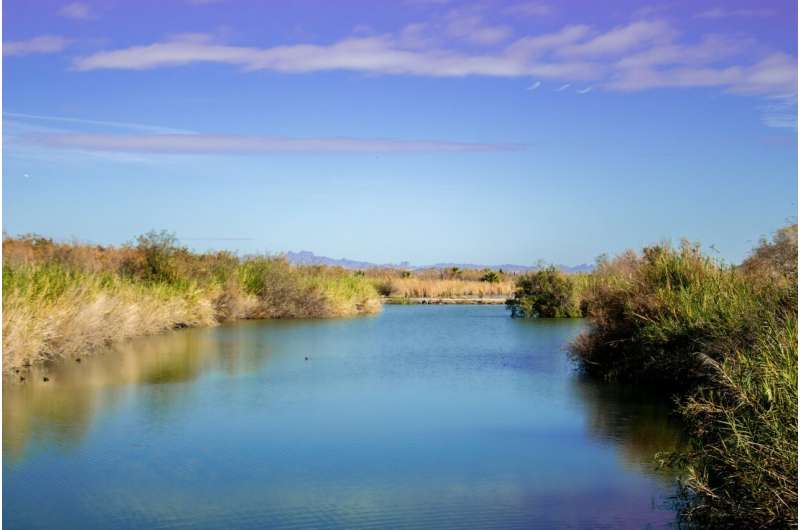This article has been reviewed according to Science X's editorial process and policies. Editors have highlighted the following attributes while ensuring the content's credibility:
fact-checked
reputable news agency
proofread
The Colorado River is shrinking: Will seven states agree on how to manage its water by March?

The seven Colorado River states face a quickly approaching deadline to present a unified plan for how to manage the drying river that provides water for 40 million people across the West.
But major disagreements remain ahead of next month's target—and the Upper Basin states, including Colorado, say they may submit their own proposal to the federal government instead.
The seven states are tasked with proposing a long-term plan to manage the crucial river and its two major reservoirs. The river system generates electric power, fuels recreation economies across the West and irrigates 5.5 million acres of agricultural lands that feed the country.
The amount of water in the Colorado River—overestimated from the beginning—is shrinking because of climate change. Lake Powell and Lake Mead, the major water storage units on the river, remain dangerously low.
All sides agree there is a crisis. But shared solutions remain elusive.
The guidelines established in 2007 that determine how to manage the river's water in times of shortage are set to expire at the end of 2026. The U.S. Bureau of Reclamation, which operates the river's two major reservoirs, has asked the states to present possible replacement guidelines in early to mid-March to avoid any disruptions from staff turnover that could result from the November election, the states' negotiators said.
While all seven states continue to meet, it's unclear whether the seven negotiators will reach a consensus by that time.
"Given the complexity of the challenges and the short amount of time for an initial submittal, it is possible that a consensus seven-state alternative may not be achieved within the next month," the Upper Basin states of Colorado, New Mexico, Wyoming and Utah said in a joint statement to The Denver Post.
Negotiators from the Lower Basin—Arizona, California and Nevada—echoed that uncertainty, with Tom Buschatzke, who is negotiating on behalf of Arizona, confirming there was doubt that a seven-state joint plan would be ready in March.
The Upper Basin states are creating their own proposal to present to federal officials in case a seven-state consensus is not reached in time, according to the basin's statement.
"This is an ongoing negotiation and there will be many touchpoints along the way," Becky Mitchell, Colorado's negotiator, said Feb. 15 during a public webinar about the negotiations. "I'm committed to working toward that early March deadline, and I know that my counterparts in the Upper Basin states are working together to have something ready. We also know that discussions will likely extend beyond this."
Even if a seven-state plan isn't presented to the Bureau of Reclamation in March, the states can continue to work together to create such a plan.
"This is not the end-all, be-all date," Mitchell said. "A seven-state solution is preferable if that can be achieved and I'm going to stay at that table—we're going to keep the invites out there. I would open the invitation to any of my Lower Basin counterparts: Let's have those hard discussions at any time. I'm available nights and weekends."
The seven states that use the Colorado River's water are divided into two basins, which access it in two different ways.
The Lower Basin states sit downstream of Lake Powell and Lake Mead and rely on releases from the two massive reservoirs. The Upper Basin states are upstream of the reservoirs and primarily rely on spring runoff.
Negotiators of the original 1922 Colorado River Compact allocated 7.5 million acre-feet of water to each basin. But the Lower Basin in recent years has used more than its allocation and drawn down the stores of water in Lake Powell and Lake Mead, which are at their lowest levels since they were filled.
Upper Basin states routinely do not use their entire allocation, as the amount of water available is determined by the amount of precipitation.
The key disagreement between the basins is who should have to give up water—and how much water should be given up to address climate change and the reservoirs' low levels.
Upper Basin states argue that before they make any cuts, the Lower Basin states must first reduce their use to below what they are allotted. Lower Basin states, however, argue both basins should make reductions, which Mitchell called impossible and untenable.
There are also places of agreement between the basins, Mitchell said. All seven states agree that they must address how climate change is shrinking the river's flows. One key area is the acknowledgment that the management system must account for water that evaporates from the river and water that is lost as it travels in canals and pipelines across the Lower Basin.
The Lower Basin has agreed to address that loss in the post-2026 guidelines by reducing those states' use by 1.5 million acre-feet a year, Buschatzke said. The Lower Basin states are still negotiating exactly how to divvy up that loss, he said.
"But more reductions are potentially needed, depending upon different hydrologies that might be in our future—especially the more dry hydrologies that are in our future," he said. "From that point, we expect the Upper and Lower basins collectively to address what remains beyond that 1.5 million."
That appears to be a sticking point for the Upper Basin.
"I think one of the first steps would be, before discussing shared shortages, for everyone in the basin to only use what they're legally entitled to," Mitchell said.
Negotiators from all seven states last spoke Feb. 2 and are planning to speak again this week, Buschatzke said.
2024 MediaNews Group, Inc. Distributed by Tribune Content Agency, LLC.




















